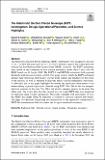The Relativistic Electron-Proton Telescope (REPT) Investigation: Design, Operational Properties, and Science Highlights
Author(s)
Baker, Daniel N.; Kanekal, Shrikanth G.; Hoxie, Vaughn; Li, Xinlin; Jaynes, Allison N.; Zhao, Hong; Elkington, Scot R.; Foster, John C.; Selesnick, Richard; Ni, Binbin; Spence, Harlan; Filwett, Rachel; ... Show more Show less
Download11214_2021_Article_838.pdf (42.67Mb)
Publisher with Creative Commons License
Publisher with Creative Commons License
Creative Commons Attribution
Terms of use
Metadata
Show full item recordAbstract
Abstract
The Relativistic Electron-Proton Telescope (REPT) instruments were designed to measure ∼2 to >18 MeV electrons and ∼18 to > 115 MeV protons as part of the science payloads onboard the dual Radiation Belt Storm Probes (RBSP) spacecraft. The REPT instruments were turned on and configured in their science acquisition modes about 2 days after the RBSP launch on 30 August 2012. The REPT-A and REPT-B instruments both operated flawlessly until mission cessation in 2019. This paper reviews briefly the REPT instrument designs, their operational performance, relevant mode changes and trending over the course of the mission, as well as pertinent background effects (and recommended corrections). A substantial part of this paper highlights discoveries and significant advancement of our understanding of physical-processes obtained using REPT data. We do this for energetic electrons primarily in the outer Van Allen belt and for energetic protons in the inner Van Allen zone. The review also describes several ways in which REPT data were employed for important space weather applications. The paper concludes with assessments of ways that REPT data might further be exploited to continue to advance radiation belt studies. The paper also discusses the pressing and critical need for the operational continuation of REPT-like measurements both for science and for space situational awareness.
Date issued
2021-07-27Department
Haystack ObservatoryPublisher
Springer Netherlands
Citation
Space Science Reviews. 2021 Jul 27;217(5):68
Version: Final published version